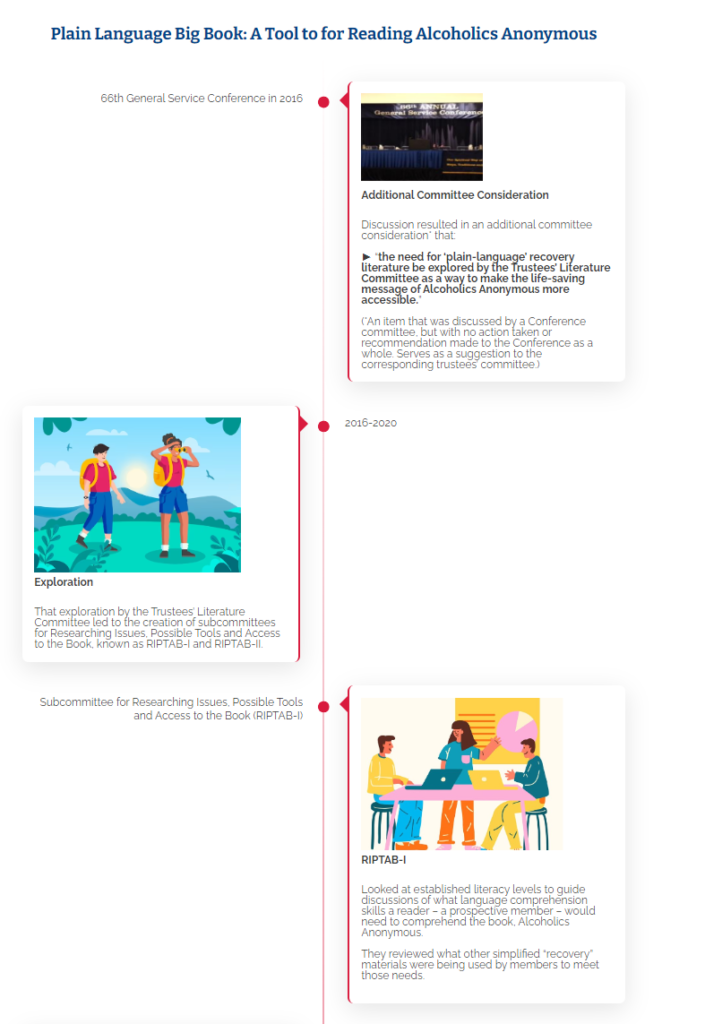Here are some Frequently Asked Questions compiled by the Plain Language Big Book Subcommittee, know as the Tools to Access the Big Book (TABB) Subcommittee as well as from notes taken at an information session held for the Southeast Region on 2/25/24 that the Chair of the Tools to Access the Big Book (TABB) Subcommittee answered.
Will this replace the Big Book?
No. The intent was and remains for the Plain Language Big Book to be a tool to access original text and to be a companion piece to it. The original Big Book is not going away and will remain in publication.
Are the Steps, Traditions, and Warranties being changed?
No. As laid out in the Conference Charter, only a 3⁄4 vote of all the groups in the world responding to a proposal has the authority to do that.
What is the need for a Plain Language Big Book?
It’s estimated that ~50% of the US population cannot easily read, comprehend, and apply the original text of our big book.
Literacy concerns revealed potential accessibility barriers related to factors such as:
- Education
- Ethnicity
- English as a Second Language
- Reading Disabilities
- Brain Injuries
- Incarceration
The Subcommittee for Researching Issues, Possible Tools and Access to the Book (RIPTAB-I) produced this video to explain everything in detail:
How did the Plain Language Big Book come about? What is the entire timeline?
This current project can be traced back to an agenda topic in 2016, at which time the General Service Conference began the assessment of the need for plain language literature. Following lots of in-depth research and reports, in 2021 the Conference as a whole decided:
“That a draft version of the book, Alcoholics Anonymous, be translated into plain and simple language and be developed in a way that is accessible and relatable to as wide of an audience as possible and that a progress report or draft be brought back to the 2022 Conference Literature Committee.”
For information on the entire detailed timeline: Plain Language Big Book Timeline
This information can also be viewed in a presentation developed by the Chair of the Plain Language Big Book Subcommittee: Plain Language Big Book- the Journey So Far. This presentation has been used at informational sessions including for CNCA06 on 1/17/24 and the Southeast Region on 2/25/24.
What is Plain Language?
Plain language is a style of writing designed for word choice, sentence structure, and layout to improve readability and increase understanding.
- The importance of plain and simple language in effective communication is recognized beyond A.A. Here are some examples:
Plain Writing Act of 2010: “…more responsive, accessible, understandable in communications with the public.” Also, saves “time, effort, and money.”
Texas Plain Language Law: “requires state agencies to use clear and simple language…importance of communicating effectively with the public.”
Boston Plain Language Pledge: “use plain language in all city communications … commits city employees to communicate clearly and effectively with residents, businesses, and visitors.”
More information can be found here:
Is this the first time A.A. has developed plain language literature?
No. Most of our pamphlets are in plain language. Also, at the time the Big Book was first published, Dr. Bob was concerned that the language was beyond the capability of blue-collar members to grasp and, as a result, 5 pamphlets (still available and known as The Akron Pamphlets) were written by Evan W. at the request of Dr. Bob during the 1940s.
Is it a word-for-word translation?
No. It is a rewrite into plain language that also reflects the scope of the task assigned to ensure that the draft “be developed in a way that is accessible and relatable to as wide of an audience as possible.
What is being translated?
Five things:
1) The Doctor’s Opinion
2) The first 164 pages of the original
3) Dr. Bob’s Nightmare
4) The Appendices
5) Forewords from the first 4 editions (which, together, are now a new Appendix VIII in the translation)
There will also be a new Preface, a new Foreword, and a Glossary. The stories (other than Chapter 1 – Bill’s Story and Dr. Bob’s Nightmare) are not being translated.
How will the Plain Language Big Book address gender and God?
Obviously we will not be changing the gender of named individuals, but where the example given is of an archetype, e.g. the Jaywalker, we will switch up things so that there is a broader representation of both men and women. Where God is mentioned, and will continue to be mentioned, this is sometime paired with ‘Higher Power.”
What considerations went into the gender-neutral language? (e.g. He/She to They/Them)
We don’t recall the specific conversations, but the idea was to provide balance in gendered language.
Did the main players in the Big Book (e.g. Fred, “A man of 30 years…”) have their genders changed?
No, only where a prior pronoun wasn’t established other than “he” or “him” was a gender re-balanced in the text.
How was the chapter “To the Wives” handled, and is the chapter name the same?
The chapter is now entitled “To the Partners”; in the spirit of inclusivity and accessibility.
What reading level will the Plain Language Big Book be at?
5th Grade – the average for adult Americans.
Was AI (ChatGPT or similar) used in the Plain Language Big Book Development?
No AI or text generator was used in the plain language draft.
How was the writer chosen and are they an A.A. member?
Alcoholics chose (via a thorough Request for Information (RFI) process that included proposals from A.A. members) the best writer for the task. The writer that was eventually chosen is a not an A.A. member. Alcoholics have been reviewing the work of the writer at all stages and making changes to ensure that the intent (as expressed in the RFI) that it “must capture the welcoming and inclusive spirit of Alcoholics Anonymous and inspire a sense of belonging and hope in the alcoholic seeking help” is followed.
Who is the anonymous contractor/writer?
Confidentiality was considered to prevent any attempts to contact or influence the writer, and to maintain integrity.
Were any Non-Alcoholics on the Tools to Access the Big Book (TABB) or Plain Language Big Book (PLBB) subcommittees?
No. All members were alcoholics.
How much has this cost?
The hard costs are $100K for the writer and approximately $40K in publishing- related expenses. $140K to date.
Why is the draft confidential to Conference members only and why can’t I see a draft?
Historically, whenever the Conference reviews new or significantly revised books or pamphlets, only the Conference Literature Committee (or whichever Committee is reviewing the item) is provided with copies of the new or revised literature before Conference begins. In the case of pamphlets, all other Conference members have been required to sign out copies of the new or revised pamphlet(s) sometime during Conference and have been given a limited time to review the literature. In the case of books, Conference members, other than those on the reviewing committees, have not been given any opportunity to review the manuscripts and have, therefore, had to base their votes entirely on the recommendation of the committee. The reasons for operating in this way are as follows:
1) In order to retain the copyright of A.A.’s literature assets, we have to be able to assert that they were not “at large,” shared widely in whole or in part within the Fellowship or shared on social media, prior to being published.
2) It usually takes several years to complete a piece of A.A. literature. During that time, multiple versions of the piece are shared with there viewing Conference Committee. If shared widely, it would be possible for the Fellowship and the public to become confused about what is in revision, what is the current revision and what is “Conference Approved.”
When circumstances such as these require that we trust the Conference process explicitly, it may be helpful to remember that Tradition 2 asserts that God’s will is expressed through the group conscience and that Concept 2 states that the Conference has become “the active voice and the effective conscience of our whole Society in its world affairs.”
When the 2023 General Service Conference got to review the work in progress, i.e., the draft of the first 6 chapters, what did the Conference think?
The response was overwhelmingly positive. Many of those who initially expressed concerns liked the plain language BB after reviewing it.
“This is the most loving thing we have done for the still suffering alcoholic.” – a formerly-skeptical Conference Delegate
What will be the title of the Plain Language Big Book ?
Plain Language Big Book: A Tool for Reading Alcoholics Anonymous.
When will members be able to see the book?
Publication date: November 1st, 2024
Will it be available in Spanish and French?
The English Plain Language is an approach and not a language. Any translation from French/Spanish would start with those respective big book versions, rather than a translation of the English-translated version.

